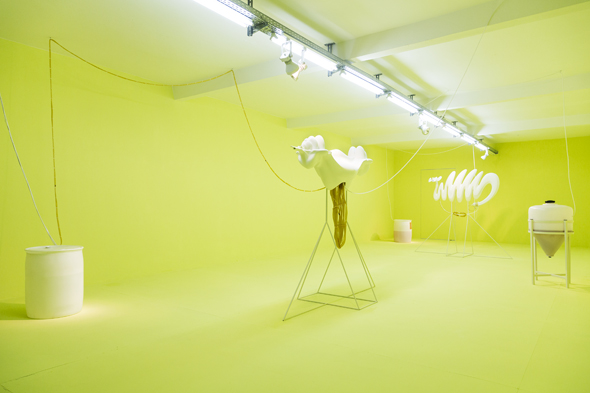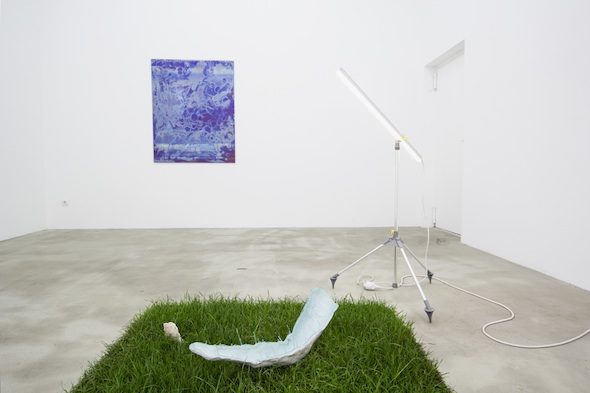Article by Alison Hugill // May. 08, 2015
It’s risky business to open Gallery Weekend on the first of May – International Worker’s Day – especially in Kreuzberg. The act of escaping or penetrating the throngs of people around Kottbusser Tor and the inevitable police barricades is a feat in itself. But just to the West in Kreuzberg 61, the art openings were in full force nonetheless. The first stop on my route was the Grand Opening of Galerie Johann König‘s outpost at St. Agnes church on Alexandrinnenstraße. The standout Brutalist building, designed by Werner Düttmann in 1964, has been renovated by the gallery to house its impressive collection. With a newly built second floor obscuring the original imposing, 20m high-ceilings of the altar area, the gallery has been transformed into a divided viewing space. The second floor was host to Katharina Grosse‘s exhibition The Smoking Kid.
Grosse’s large-scale abstract paintings on canvas were a perfect fit for the space – but the symmetry and harmony of the whole composition made it profoundly uninteresting. The paintings merged seamlessly, like stained-glass windows on a church. The wood-clad ceiling addition, on the other hand, was blasphemous in the otherwise stark concrete space. Downstairs, on the periphery of a display of König’s other represented artists, Jeppe Hein‘s ‘Mirror Balloons’ (2015) appeared to have floated up the small side chapel opposite the entrance. The reflective, metallic balloons seemed to defy gravity: they looked anything but weightless, giving a much-needed fantastical element to the otherwise insipid display.
Around the corner from St. Agnes, at Duve, another fantasy emerges in the work of Marguerite Humeau. The London-based artist and designer has positioned herself at the crossroads of scientific inquiry, developing complex – albeit occasionally far-fetched – explanations for her installations. The walls of the one-room gallery are allegedly coated with 2mg of deadly, poisonous ‘Black Mamba’ venom, sourced from a Floridian lab. The sculptural creatures she has created from polystyrene, tell their own tales of mythic proportions, with pink fluids oozing from their ‘bodies.’ Meanwhile, in the neon green room, Cleopatra’s disembodied voice sings in the nine extinct languages that she spoke. Once again, Humeau proves not only her aesthetic prowess, but her ability to convincingly theorize other-worldly creatures and beings, and to make them relevant once more.
 Marguerite Humeau – Installation View at Duve Berlin; Photo by Maike Wagner
Marguerite Humeau – Installation View at Duve Berlin; Photo by Maike Wagner
My final stop was the less hyped (and thus more intriguing) group show at Soy Capitan. The gallery, set in a back courtyard off Prinzessinnenstraße, next to KLEMM’S, exhibited the work of five artists – Mikkel Carl, Dominik Gohla, Pakui Hardware, Daniel Stempfer and Anna Zett – under the curatorial direction of Gislind Köhler.
Though decidedly minimal in visual terms, the show packed a lot of conceptual heat. The small exhibition space resonated with the sound of Anna Zett‘s audio piece ‘Text-to-Speech.’ In the monologue, the German-accented female voice speaks of the power of the ‘North American Native English Speaker’ as an agent of capitalist ideology, who embodies the “future of capitalism.” At one point she asks: “Is the Empire a computer or is the Empire an American English voice of human origin that has been subjected to sound editing?” The removal of discernible accents goes hand-in-hand with a purging of unnecessary details or aura from the global art world – towards the complete digitalization, and marketization of speech in art practice.
 Crystal Readings Group Show, Installation View at Soy Capitan, Berlin; Photo courtesy of Soy Capitan
Crystal Readings Group Show, Installation View at Soy Capitan, Berlin; Photo courtesy of Soy Capitan
As Zett provokes a series of questions and criticisms, the various objects in the space seem to respond with their own critical, at times dystopian, future visions. Mikkel Carl‘s anodized titanium sheets – texturized and colourful – explore the processes of degeneration and re-structuring of metals as metaphors for cultural structures and codes, while Daniel Stempfer‘s ‘For Ahmose Who Liked Honey’ (2015) fills the room with a smell of detergent as it flows down a spiralled tube into a paper bag on the floor. The piece refers to the Egyptian Princess Ahmose Meritamun who died a premature death by atherosclerosis – the hardening of the arteries – as a result of her ‘modern lifestyle.’ Her subsequent mummification and availability for scientific study thousands of years later raises the question of what kind of people are allowed to leave their mark in the world.
The exhibition openings in Kreuzberg were made all the more exciting by the obstacle course endured to attend them, and their fruits will remain on display well into June.
___________________________________________________________________________________
Additional Information
GALERIE JOHANN KOENIG, ST. AGNES
“The Smoking Kid” – KATHARINA GROSSE
Exhibition: May 01 – Jun. 21, 2015
Alexandrinnenstraße 118-121 (click here for map)
DUVE
“Echoes” – MARGUERITE HUMEAU
Exhibition: Apr. 30 – Jun. 06, 2015
Gitschinerstraße (click here for map)
SOY CAPITAN
“Crystal Readings” – GROUP SHOW
Exhibition: May 01 – Jun. 12, 2015
Prinzessinnenstraße 29 (click here for map)
___________________________________________________________________________________
Alison Hugill has a Master’s in Art Theory from Goldsmiths College, University of London (2011). Her research focuses on marxist-feminist politics and aesthetic theories of community, communication and communism. Alison is an editor, writer and curator based in Berlin. www.alisonhugill.com























